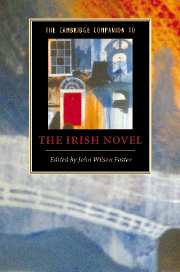Book contents
- Frontmatter
- Introduction
- 1 The novel before 1800
- 2 The national tale and allied genres, 1770s-1840s
- 3 The novel of the big house
- 4 The Gothic novel
- 5 Catholics and fiction during the Union, 1801-1922
- 6 Irish modernisms, 1880-1930
- 7 James Joyce
- 8 Region, realism and reaction, 1922-1972
- 9 The novel in Irish
- 10 Women novelists, 1930s-1960s
- 11 Two post-modern novelists: Samuel Beckett and Flann O’Brien
- 12 Life writing in the twentieth century
- 13 The novel and the Northern Troubles
- 14 Contemporary Irish fiction
- Index
Introduction
Published online by Cambridge University Press: 28 January 2007
- Frontmatter
- Introduction
- 1 The novel before 1800
- 2 The national tale and allied genres, 1770s-1840s
- 3 The novel of the big house
- 4 The Gothic novel
- 5 Catholics and fiction during the Union, 1801-1922
- 6 Irish modernisms, 1880-1930
- 7 James Joyce
- 8 Region, realism and reaction, 1922-1972
- 9 The novel in Irish
- 10 Women novelists, 1930s-1960s
- 11 Two post-modern novelists: Samuel Beckett and Flann O’Brien
- 12 Life writing in the twentieth century
- 13 The novel and the Northern Troubles
- 14 Contemporary Irish fiction
- Index
Summary
Beginnings
The Irish novel emerged in the tangle of social, cultural, commercial and literary interrelations of Great Britain and Ireland. It shares its genesis with the English novel, as do all English-language national traditions of the genre, though much older and distinctively native Irish narrative forms and energies influenced its course later. When we write of the eighteenth century (the century in which the novel written by Irish authors decisively appeared) and use the phrase 'the Irish novel', we are necessarily referring to novels written by authors who, irrespective of birthplace, inhabited both England and Ireland, but chiefly England, and who thought of themselves as English or possibly both English and Irish, with the first identity being the defining one. The once standard History of the English Novel (ten volumes, 1924-39) by Ernest A. Baker, and the once standard short histories of the English novel that took much from Baker - The English Novel: A Short Critical History (1954) by Walter Allen and The English Novel: A Panorama (1960) by Lionel Stevenson - like the once standard history of the genre's starting decades, The Rise of the Novel (1957) by Ian Watt, do not normally identify as Irish those early novelists who had in fact some claim to the title. If they did (Baker calls Thomas Amory 'half an Irishman'), the Irishness of the authors was regarded as of little consequence and this seemed to be a view derived from these almost exclusively Protestant or Anglo-Irish authors themselves, who failed to stake their claim to Irishness.
- Type
- Chapter
- Information
- The Cambridge Companion to the Irish Novel , pp. 1 - 21Publisher: Cambridge University PressPrint publication year: 2006
- 1
- Cited by

